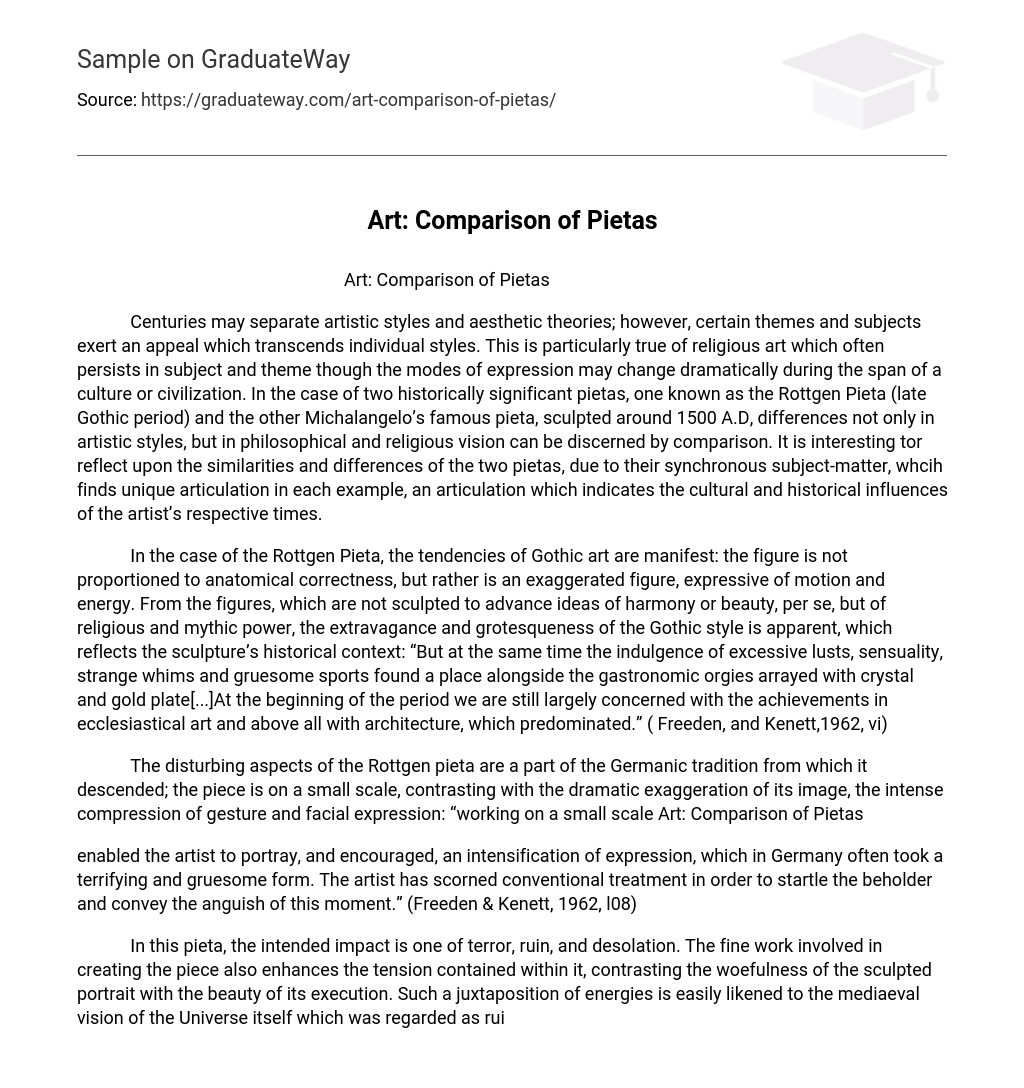Centuries may separate artistic styles and aesthetic theories; however, certain themes and subjects exert an appeal which transcends individual styles. This is particularly true of religious art which often persists in subject and theme though the modes of expression may change dramatically during the span of a culture or civilization. In the case of two historically significant pietas, one known as the Rottgen Pieta (late Gothic period) and the other Michalangelo’s famous pieta, sculpted around 1500 A.D, differences not only in artistic styles, but in philosophical and religious vision can be discerned by comparison. It is interesting tor reflect upon the similarities and differences of the two pietas, due to their synchronous subject-matter, whcih finds unique articulation in each example, an articulation which indicates the cultural and historical influences of the artist’s respective times.
In the case of the Rottgen Pieta, the tendencies of Gothic art are manifest: the figure is not proportioned to anatomical correctness, but rather is an exaggerated figure, expressive of motion and energy. From the figures, which are not sculpted to advance ideas of harmony or beauty, per se, but of religious and mythic power, the extravagance and grotesqueness of the Gothic style is apparent, which reflects the sculpture’s historical context: “But at the same time the indulgence of excessive lusts, sensuality, strange whims and gruesome sports found a place alongside the gastronomic orgies arrayed with crystal and gold plate[…]At the beginning of the period we are still largely concerned with the achievements in ecclesiastical art and above all with architecture, which predominated.” ( Freeden, and Kenett,1962, vi)
The disturbing aspects of the Rottgen pieta are a part of the Germanic tradition from which it descended; the piece is on a small scale, contrasting with the dramatic exaggeration of its image, the intense compression of gesture and facial expression: “working on a small scale Art: Comparison of Pietas
enabled the artist to portray, and encouraged, an intensification of expression, which in Germany often took a terrifying and gruesome form. The artist has scorned conventional treatment in order to startle the beholder and convey the anguish of this moment.” (Freeden & Kenett, 1962, l08)
In this pieta, the intended impact is one of terror, ruin, and desolation. The fine work involved in creating the piece also enhances the tension contained within it, contrasting the woefulness of the sculpted portrait with the beauty of its execution. Such a juxtaposition of energies is easily likened to the mediaeval vision of the Universe itself which was regarded as ruinous and evil, but also indicative of God’s mastership of Creation.
By contrast, Michelangelo’s pieta finds articulation through the harmonious representation of human anatomy. Rather than stylizing or moving the image of Christ and Mary toward abstraction and myth, Michelangelo portrays them heroically, realistically. This approach was both a gesture toward and a break with traditions of the past: “In the older representations the proportions of the body of Christ were usually reduced to those of a child. Michelangelo keeps the natural proportions and achieves the expression of this idea by more subtle means, as for example by the way Mary holds the body of Christ with her right arm under his shoulders, as a child is held.” (De Tolnay,1943, 91)
The feeling of this pieta is one of sad harmony and peace; tranquility and perfection. The feeling demonstrates the change in Christian philosophy which was moving closer to an embrace of the feminine aspects of the religion: “By the first half of the 13th cent., the role of the Virgin Mary as the intermediary between God and humanity is stressed in the sculptural programs of Laon, Notre-Dame de Paris, and the north transept of Chartres.”(“Gothic Architecture and Art,” 2004) The impact of Michelangelo’s sculpture is to make heroic the actual anatomies of human beings and cast them through magnificent gesture and splendid craftsmanship into a vision worthy of the religious myths they embodied. This style was considered experimental when the sculpture was created: “Michelangelo’s PietB is one of those famous works, like the Mona Lisa or the Venus de Milo, that it is almost impossible to see afresh. In 1500, however, it was a novelty in Italian art and at first must have looked strange to the Romans who flocked to see it. (Hibbard, 1985, p). Some of this “strangeness” can be recovered by the modern student who, in viewing the progression from the Rottgen pieta to Michelangelo’s pieta, can clearly discern the change in vision and artistic style that evolved through the centuries.
References
Gothic Architecture and Art. (2004). In The Columbia Encyclopedia (6th ed.). New York: Columbia University Press.
De Tolnay, C. (1943). The Youth of Michelangelo. Princeton, NJ: Princeton University Press.
Freeden, M. H., & Kenett, F. L. (1962). Gothic Sculpture: The Intimate Carvings. Greenwich, CT: New York Graphic Society.
Hibbard, H. (1985). Michelangelo (2nd ed.). Cambridge, MA: Harper & Row.





